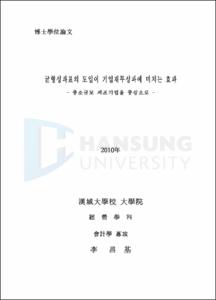균형성과표의 도입이 기업재무성과에 미치는 효과
= A Study on the Effect of Balanced Scorecard on Firms' Financial Performance
- Type
- Thesis
- Alternative Title
- 중소규모 제조기업을 중심으로
- Department
- 대학원 경영학과
- Issued Date
- 2010
- Publisher
- 한성대학교 대학원
- Files in This Item:
-
-
Download
 000000609405.pdf
기타 데이터 / 1.07 MB / Adobe PDF
000000609405.pdf
기타 데이터 / 1.07 MB / Adobe PDF
-
Items in Repository are protected by copyright, with all rights reserved, unless otherwise indicated.